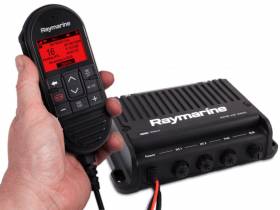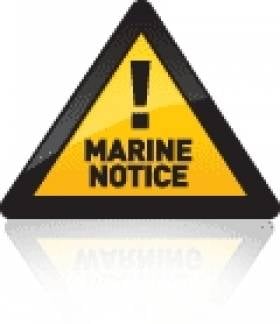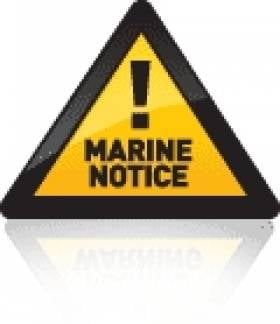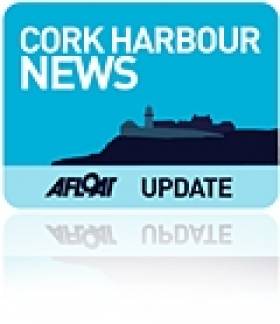Displaying items by tag: Radio
Ahead of its broadcast this weekend, Newstalk previews A Sea of Sound, a new radio documentary that explores the impact of noise pollution on marine wildlife.
Marine mammals such as dolphins and whales effectively ‘see’ through sound in the water. “So to understand the life they lead, as the Irish Whale and Dolphin Group’s Simon Berrow says, we need to “think acoustically”.
Producer John Higgins spoke to Berrow and other environmental stakeholders for the documentary, which also features some of the remarkable sounds of whales and dolphins communicating beneath the waves — and explores the sounds that threaten them, from seismic surveys to military sonar and more.
A Sea of Sound will be broadcast on Newstalk this Sunday morning 27 March at 7am, with a repeat on Saturday 2 April at 9pm. It will also be available as a podcast.
Last Places Open On Latest VHF Radio Course At INSS
#INSS - Anyone who wants to get certified in the use of short-range VHF marine radio should look to the Irish National Sailing & Powerboat School (INSS) in Dun Laoghaire, which is running its next course from Monday.
The four-evening course taking place next Monday 22, Tuesday 23, Thursday 25 and Friday 26 October (from 6.30pm to 9.30pm each session) will put you hands-on with a real VHF radio rather than a computer-based simulator.
The INSS promises that no more than two people will share a radio at any one stage of the course which, along with the complimentary set of course notes, will equip you to pass the short exam and leave as “a hugely competent user of VHF radio”.
Over the four evenings you will learn the NATO phonetic alphabet, how to conduct day-to-day communications and make emergency or distress calls, and the workings of the GMDSS network and system.
This course is also a prerequisite for many other practical courses, and is a legal requirement for anyone who plans to use a VHF radio set.
Places are still available for next week’s course but dates are also open in the new year in late January, February and March, as well as four other courses scheduled for 2019.
Pair Trawling Up For Debate On ‘Countrywide’
#Fishing - Pair trawling was a matter of debate on RTÉ Radio 1’s Countrywide this past Saturday (3 December).
The segment follows a call by the Irish Wildlife Trust to ban the practice of pair trawling — or trawling a single net between two fishing boats — in Ireland’s inshore bays and estuaries.
Darragh McCullough welcomed the trust’s campaigns officer Padraig Fogarty and Hugo Boyle of the Irish South & East Fish Producers Organisation to discuss the purposes of the practice, its benefits to the fishing industry and why conservationists are concerned over effects on the ecosystem.
Listen back to the interview on the RTÉ website HERE.
Ireland's First Surfer Subject Of New Radio Documentary
#Surfing - He's the Irish surfing hall-of-famer who "came out of nowhere".
And now Joe Roddy is the subject of a fascinating radio documentary about his decades of aquatic exploits and ingenuity on Newstalk, both online and broadcast tonight (Saturday 23 January) at 10pm.
As TheJournal.ie reports, Surfing at the Crossroads brings the now 80-year-old Roddy to Valentia Island, where he recounts building what's regarded as Ireland's first surfboard – way back in the 1940s.
But even before then he was assembling his own makeshift vessels and gadgets to enable him to go canoeing, snorkelling – even spear-fishing.
The latter of which Roddy excelled at enough to represent Ireland at the World Championships in Cuba in 1967 - recording a incredible 32-metre dive in the process.
TheJournal.ie has much more on Joe Roddy's story HERE.
Seascapes On RTE Radio 1 Has Much To Celebrate After 25 Years
#seascapes – The maritime community in Ireland is a mystery to the vast majority of the rest of the population. Admittedly anyone Irish will sing enthusiastically about how good it is to be entirely surrounded by water. But for most folk among a people who like to think that they're basically rural even if the reality is they're increasingly urban, the sea is seen as no more than a useful barrier, while the coast is only briefly a fun place at the very height of a good summer.
The sea and the coastal interface are not seen as an exciting world in itself, a unique environment which deserves to be explored, enjoyed and utilised in practical and often beneficial ways. On the contrary, the popular view of the plain people of Ireland is that the less they know about the sea, the better. And the unspoken corollary of this is that anyone who seeks to go to sea for recreation is at best a bit odd, maybe even a misfit ashore, while those who work on the sea only do so because they couldn't get a job on land.
Here at Afloat.ie, in its various manifestations over the past 52 years, we've been trying to spread mutual understanding and useful information among the many and varied strands of those who go afloat for sport and recreation in Ireland and beyond. We know this is largely a matter of preaching to the converted. But we also try to do our bit to welcome those who may be newcomers to the world of boats, while remaining keenly aware of the drawbacks of over-selling our sport, our hobby – our obsession, if you wish.
Sailing and boating in Ireland can be rugged enough. Thus the sport in all its forms can only expand in a sustainable way if it attracts people who will themselves bring something positive to the party, for interacting usefully with boats is not a passive affair. And there has been a certain level of success. Over the years, while there was an understandable blip in boating numbers during the recent recession, the graph has been reasonably healthy when it's remembered that rival sport and entertainment attractions are proliferating all the time, while the increasing availability of holidays afloat in sunnier climates makes the promotion of boating activity within Ireland more problematic.
Fifty-two years ago, beginning a process of regular communication among Ireland's recreational boating community was quite a challenge. But it was a very straightforward project compared with inaugurating a regularly weekly broadcast maritime programme for all listeners on national radio in a country notably averse to the sea. Yet it all began 25 years ago, and it's still going strong.
So how do you celebrate 25 years of a niche radio programme, a little Irish maritime magazine of the air? It would be too much to expect a documentary on primetime television. And even an extra-long gala edition on the national radio airwaves at peak listening times might well be counter-productive. So it seems the answer is that the best way to celebrate 25 years of Seascapes on RTE Radio 1 is to publish a book well-filled with some of the key broadcasts with which it has been associated. And as those now-printed broadcasts include a maritime-themed series of the prestigious Thomas Davis Lectures, you mark the anniversary by sending out those as broadcasts again in their own right twelve years after their first transmission.
It may all sound almost devious, a matter of managing to slip the Seascapes celebrations in under the RTE management radar. But those of us who have been banging the maritime development drums for a very long time are well aware that, though the tide is definitely turning, there's still a huge underlying resistance to anything to do with the sea and boats, and it takes an element of cunning to get the message across such that, in time, the people are themselves singing from the same hymn sheet, and thinking it was all their idea in the first place.
But the founder of Seascapes 25 years ago, RTE's Cork reporter Tom MacSweeney, makes your average terrier look like a tired old dog. A sailing and maritime enthusiast himself even though his family had been from a non-maritime background, he had as a child in Cork been inspired by his grandfather's great respect for seafarers, and the vital task they performed in keeping Ireland connected with the rest of the world. He could see the sea all about us, and Cork is the most maritime of cities. So he just kept nagging RTE until they gave him a quarter of an hour once a week back in 1989 to put on a maritime programme for an island nation. And though it has been shifted around in the schedules, it is now a solid half hour every Friday night at 10.30pm, a worthy fulfilment of RTE's public service remit - you really do get a sense of Seascape's nationwide listening community, while podcasts make it more accessible than ever.
The sheer volume of material from all round Ireland's coasts, from our lakes and rivers, and from Irish seafarers abroad, is simply monumental, a treasure trove. So in producing the book (it's published by Liffey Press at €20 with all royalties going to the Lifeboat Service), they'd to wield a fierce scalpel. And though it includes the complete set of Thomas Davis lectures from twelve years ago, it's still of manageable size (in other words, you can read it in bed), while giving a good overview and flavour of the kind of material Seascapes broadcasts, and what we might call the house style.
In Tom MacSweeney's days of producing and presenting it from 1989 until he retired from RTE in January 2010, it has to be agreed that very occasionally the nagging which got Seascapes its slot in the first place sometimes spilled over onto the airwaves in the programme itself. Okay, we all know that Ireland is not as sea-minded as it might be. But things are slowly improving in this, and they might improve more quickly if the maritime movement relied more on the path of gentle encouragement and inspiring example rather than constantly reiterating the tedious refrain of "the government should do this, the government should do that....."
From time to time, I have to confess I thought the worst possible thing was to get the government involved at all, having seen what the official encouragement and enforcement of the Irish language had achieved since the establishment of the state. There'd be occasions when you'd think the best way to turn the Irish into a nation of doughty sailors would be to declare seafaring illegal. The people would have taken to boats in their droves....But nevertheless the tide is slowly but definitely turning, and in today's less frenetic atmosphere of businesslike maritime promotion and development, we're becoming more comfortable in our relationship with the sea.

Man of the sea. Rear Admiral Mark Mellett DSM on exercises with the Naval Service off the Cork coast.
So it was entirely appropriate that, in the launching of the Seascape's compendium Sailing By, the main speaker in both the Cork Harbour Commissioners' building on the Friday night (November 28th), and in the National Maritime Museum in Dun Laoghaire on Monday, was Rear Admiral Mark Mellett DSM, our most distinguished navy man, who has risen to the august heights of Deputy Chief of Staff of the Defence Forces.
If you requested Central Casting to provide an Irish Admiral who conveys the expected air of competence with the necessary gravitas and presence, while still having that essential Irish twinkle, then they'd send you Mark Mellett. We'd most of us heard of his steady rise through the senior ranks, but for many of us in the National Maritime Museum on a damp December night, it was the first experience of seeing Admiral Mellett in a professional and public capacity. For people from a very wide range of interests and activities in the maritime sphere, it was very encouraging – we feel we now have a spokesman who can ably represent us at every level, however formal or high powered, while at the same time retaining the human touch.
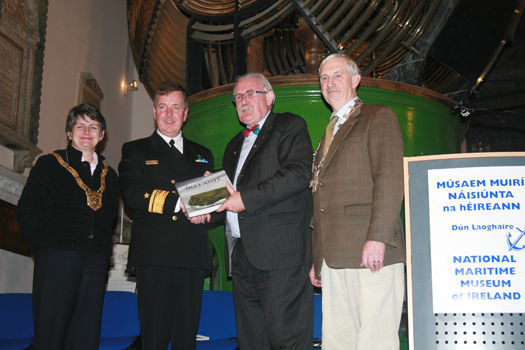
Top people at the launching of the Seascapes book Sailing By are (left to right) Cllr Marie Baker (Cathaoirleach of Dun Laoghaire-Rathdown County Council), Rear Admiral Mark Mellett DSM (Deputy Chief of Staff , Defence Forces), Marcus Connaughton of Seascapes, and Richard McCormick, President of the National Maritime Museum. Admiral Mellett is being presented with the book The Atlantic Coast of Ireland, as he already has his own copy of Sailing By – he wrote the foreword.
His enthusiasm is palpable, and he provided a foreword for the book which speaks from the heart, yet provides a practical and businesslike outlook. In fact, that was the flavour of the evening in the National Maritime Museum, as it was hosted by Richard McCormick, the recently elected President of the National Maritime Museum, and the speakers included the Cathaoirleach of Dun Laoghaire-Rathdown County Council, Cllr. Marie Baker, and Tom McGuire, head of RTE Radio 1, who knows better than anyone just what has been needed to keep Seascapes on the airwaves for 25 years.
Most of all it has of course been the sheer dogged determination of Tom MacSweeney working on his own as producer and presenter in RTE's Cork studio, followed by his successor Marcus Connaughton, who came in as producer when the Thomas Davis Lectures were added to an already almost impossibly demanding schedule in 2002, and stayed on to become presenter eight years later.
They're two very different people. Tom is so involved and enthusiastic that occasionally his own personality, opinions and attitudes cloud the issue. He's a complex man with many interests, not least of them being a national Vice President of the St Vincent de Paul Society. But as regular visitors to Afloat.ie will know, he continues to broadcast his own maritime programmes through community radio, and he's a much-sought-after speaker on sea matters. Recently, he gave a sold-out talk - How Stands Our Island Nation? - to the Dublin Bay Old Gaffers Association in the Poolbeg Y&BC, and while he had the usual serious message, it was leavened by his sharp wit, with the laugh of the evening being provided by his reading of the pained official letter from an Irish Lights Manager complaining about the sheer incompetence and slovenly carelessness of Brendan Behan when he was employed as a painter renovating the St John's Point lighthouse in County Down.
That said, it was a telling lesson in the importance or otherwise of maritime affairs in Ireland's national and cultural life in times past, that the story of a noted playwright making a complete hames of painting a lighthouse was something you knew would register more readily with a general audience than anything of more direct nautical interest, and it is an awareness of the need to reach out gently to the general public which sets the tone of Marcus Connaughton's presentation of Seascapes.
He arrived in the job first as producer, and then as producer/presenter, with no personal baggage in maritime matters. His background was in music production and public relations, and a couple of years ago he brought seventeen years of research and writing to a successful conclusion with the defining biography of Rory Gallagher. But gradually he has become absorbed in and intrigued by the world of boats and the sea. As one of the speakers on Monday night put it, one of the most quietly impressive peformances you'll see is Marcus – who is by no means a small man – sidling into the crowd at some maritime gathering, armed with microphone and recorder, ready and willing to give a voice to the voiceless.
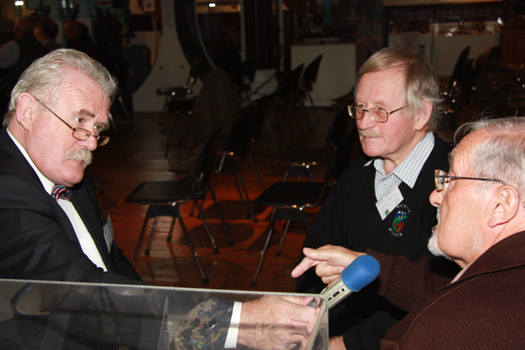
Man at work – Marcus Connaughton records the memories of Alan Martin and Jimmy Carthy of the Dublin Dockworkers Preservation Society
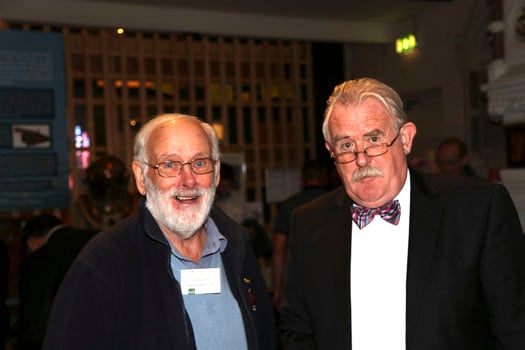
Tim Magennis (left) President of the Dublin Bay Old Gaffers Association, with Marcus Connaughton. Once upon a time, they were work colleagues in the PR Department of Bord Failte

The book launch begins to become a party – Con Murphy of the National YC (left) and Brian Craig of the Royal St George YC getting their copies of Sailing By signed by Marcus Connaughton in the National Maritime Museum. Photo: W M Nixon
The changeover to a new presenter was fairly gradual, but very marked in one thing – he changed the signature tune. When Seascapes started in 1989, they simply borrowed the music which precedes the BBC Shipping Forecast, Ronald Binge's "Sailing By".
"Sailing By" in almost any form is the sound of syrup being poured over sugar lumps, but some folk loved it, so the change to the brisk tone of Simon Mayer's The Reel Thing wasn't universally popular, even if welcomed by those of us trying to cut down on the sucrose.
Yet it's surely an appropriate 25th anniversary sweetener that the published compendium of Seascapes stories is titled Sailing By, and the cover is a fine photo of the renowned pilot cutter Jolie Brise sailing by the Fastnet Rock. It was taken by Brian Carlin of Tralee, who subsequently went on to be the award-winning photographer aboard the Volvo 65 Team Vestas, which unfortunately managed to do some excessive impactive navigation off Mauritius during the Volvo World race last weekend. It was certainly not the photographer's fault, but it heightened the sense of an Irish maritime community worldwide that at Monday night's gathering, Marcus was able to tell us that not only was Brian all right, but that in contacting his father to say so, he requested that the message be passed on to Seascapes as soon as possible.
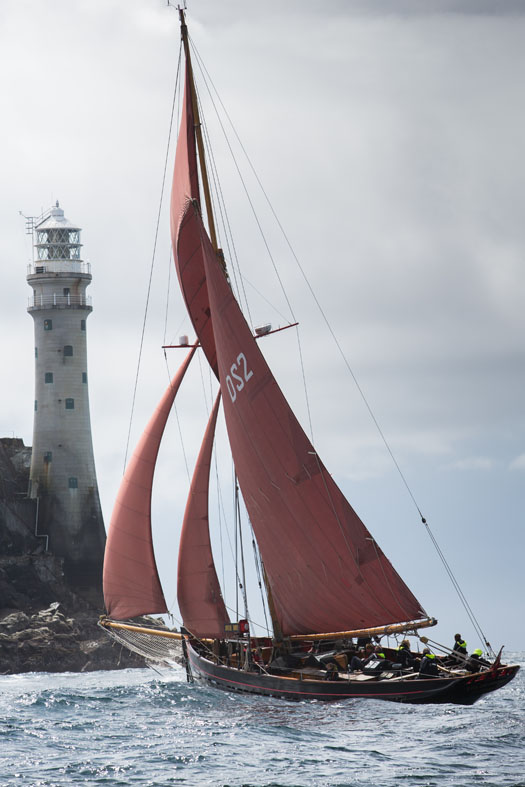
One of award-winning photographer Brian Carlin's studies of Jolie Brise sailing by the Fastnet Rock. Photo: Brian Carlin
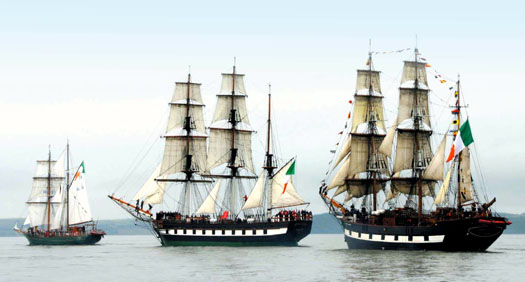
The top moment – it's 2005, and the Seascapes team are on board Asgard II as she leads the Dunbrody of New Ross, and the Jeanie Johnston of Tralee, in the Parade of Sail at the Tall Ships visit to Waterford. Photo: Dave Osborne
As for Marcus's own special recollections of his years with Seascapes, we allowed him six and he ranked them: (1) Being on Asgard II in Waterford with the Tall Ships in 2005, (2) at sea off Hook Head with Martin Colfer amidst enormous schools of lively dolphins, (3) in Galway during both Volvo visits, (4) being far up his beloved Munster Blackwater beyond Ballinatray at the top of the tide, (5) celebrating 25 years of the Killybegs Fishermen's Association at a monster party in the great Donegal port, and (6) being in the renovated National Maritime Museum in Dun Laoghaire when it was re-opened by President Michael D Higgins.
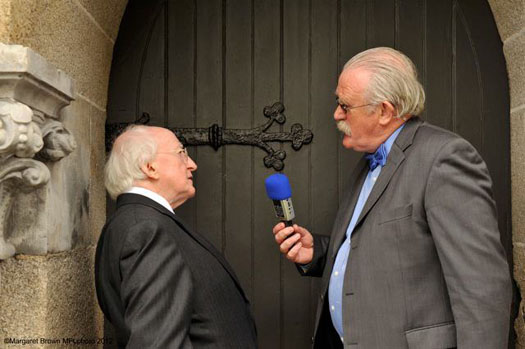
Presidential thoughts of the sea and seafaring in Ireland – Seascapes interviews President Higgins after he has re-opened the restored National Maritime Museum in Dun Laoghaire. Photo: Margaret Brown
Seascapes was of course broadcast as usual last night at 10.30pm, and Marcus Connaughton will be signing copies of Sailing By in Waterstones in Cork this afternoon from 2.0pm to 5.0pm. The first of the six Thomas Davis lectures from 20012 – Paddy Barry's lyrical account of sailing round Ireland – will be broadcast on Friday December 19th, and they'll continue weekly until the final one on February 6th, which is my own item about why most people in Ireland think sailing enthusiasts are so odd. As mentioned at the Glandore Summer School in July, I've changed my mind about some aspects of that, and I'll probably have changed it yet again when Marcus provides me with the space for further thoughts on the matter on Seascapes some time after February 6th.
But meanwhile, happy birthday to Seascapes – you provide a wonderful example of genuine public service broadcasting.
Marine Notice: Statutory Radio Surveys On Irish Sea-Going Vessels
#MarineNotice - The latest Marine Notice from the Department of Transport, Tourism and Sport (DTTAS) advises that it has established a panel of authorised surveyors to conduct statutory radio surveys on Irish sea-going vessels, including fishing vessels.
This panel is established from 1 October 2014 till 1 October 2017. Owners of vessels in the following categories requiring a periodical/annual radio survey should contact a panel radio surveyor to arrange these surveys:
• Irish fishing vessels of 15 metres length overall or more,
• Irish domestic trading passenger ships of Classes B, C, D, II(A), III, and VI,
• Irish domestic trading cargo vessels of 300GT or more, but less than 500GT.
On completion of such surveys, the panel surveyors will inform the Marine Survey Office (MSO) with regard to the issue of any required statutory certificate to the vessel.
In general, from 1 January 2015 the MSO will not issue statutory certificates to vessels which have not completed the required statutory radio survey. Owners of vessels requiring an 'initial' radio survey should contact the MSO.
Operators of vessels where the statutory certificates are issued by a Recognised Organisation on behalf of the DTTAS should continue to utilise the services of the Recognised Organisation for the completion of these statutory radio surveys.
Contact details for the panel of surveyors are included in the annex to Marine Notice No 58 of 2014, a PDF of which is available to read or download HERE.
Youghal Lifeboat Radio Doc Traces 175 Years of East Cork Rescues
#rnli – A new radio documentary on CRY104fm entitled "Saving Lives At Sea" airs tomorrow night (Tuesday the 29th of April) at 7pm tracing the history of the Youghal RNLI as it celebrates 175 years in existence.
Beginning with one of Youghal Lifeboats most dramatic rescues on the 1st of August 1984, the programme will trace the History of the Lifeboat station right up to the present day.
In the programme we will hear from a large number of volunteers both past and present from Youghal RNLI who have regularly put their lives at risk to keep the waters of East Cork safe while looking at the changes that have taken place in both technology and in the Lifeboat station since 1839 and in particular since the 1970's when the changes in RNLI technology and capabilities have been vast.
In total Youghal's Lifeboats have been launched on over 340 occasions and have saved over 200 lives which in itself is a remarkable achievement for an organisation which is solely run by volunteers and is dependent on people's goodwill and generosity in order to survive financially and maintain a lifeboat service on our coastline.
The programme will celebrate the bravery and truly heroic actions of Youghal RNLI volunteers by retelling some of the stations most dangerous sea rescues while also examining how a tragedy brought a community together in grief but also highlighted the extraordinary dedication and selflessness of RNLI volunteers which brought comfort to two grieving families.
The programme will also look at the extended RNLI family from the partners and children that remain on shore while the volunteers embark on potentially dangerous rescues to the vitally important fundraising arm of the Youghal RNLI whose often unseen work ensures that the lifeboat service remains intact for the people of Youghal and the surrounding areas.
Above all in what will be compelling listening for all those with an association with the sea "Saving Lives At Sea" will highlight how vital the lifeboat service is to the Community of Youghal while raising awareness of the work this most deserving charity does.
More on www.cry104fm.com
#radiosurveyor –The Department of Transport, Tourism and Sport is establishing a panel of radio surveyors for 2014 and the closing date for applications is in three weeks time.
Surveyors will carry out statutory radio surveys on Irish sea-going vessels including fishing vessels.
The Marine Survey Office (MSO) will select Surveyors and organisations for entry onto the panel. The panel will be established for a period of time of 3 years, subject to satisfactory performance. The MSO will monitor the performance of the Surveyors and organisations on the panel and this will include audits of the panel surveyor's activities, monitoring of survey reports submitted to the MSO and follow up by the MSO in relation to complaints or the receipt of incident reports concerning surveyed vessels.
The Department of Transport, Tourism and Sport is interested in appointing suitably qualified surveyors and organisations to a panel from which vessel owners may select a surveyor or company to survey their vessel for compliance with the relevant statutory provisions. The person commissioning the survey will cover the Surveyor's fees and to Surveying Irish sea-going vessels, within scope and unclassed, for compliance with the relevant Irish statutory radio requirements – as listed in the appendix
A copy of the request for applications document is included in the PDF to downad below.
Interested parties can access the tender information by visiting the eTenders Public
Procurement website at: http://etenders.gov.ie.
The closing date for applications is 15:00 on Friday 28th March
Irish Maritime Administration,
Department of Transport, Tourism and Sport,
Leeson Lane, Dublin 2, Ireland.
'Message In A Bottle' Radio Doc Shortlisted For Prix Italia Award
#Radio - RTÉ Radio's Documentary on One strand has made the shortlist of the 2013 Prix Italia broadcasting awards for a wonderful tale of a connection made across the ocean.
Listed among the top three for 'Overall Quality' in the awards shortlist, Message in a Bottle begins on Christmas Day 1945, when 21-year-old American servicemen Frank Hayostek stuffed a note in a bottle and threw it from the deck of his troop carrier.
After eight months at sea, the bottle washed up on a beach near Dingle where it was found by 18-year-old Breda O'Sullivan, who began a correspondence with Frank that soon blossomed into a firm friendship.
Saving up for six years as they wrote back and forth, Frank finally made the trip to Ireland to meet Breda in person - with the whole world watching.
Made by Peter Mulryan with assistance from Liam O'Brien, and originally broadcast on RTÉ Radio 1 on 4 August 2012, the 45-minute documentary is available to stream or download from the RTÉ website.
The winners are due to be announced this afternoon at 4pm CET with a live stream available from the Prix Italia homepage.
Cobh History Radio Doc Is A Blast From The Past
#CorkHarbour - Many thanks to the Hurdy Gurdy Museum in Howth (@HurdyGurdyRadio on Twitter) for tipping us off to this fascinating radio documentary on the history of the port of Cobh in Cork Harbour, first broadcast all the way back in August 1954.
The programme, produced for Radio Éireann, charts the history of the town well before the visit of the ill-fated Titanic in 1912 and its role as the point of departure for emigrants during the famine, all the way back to its beginnings in 1780.
The entire documentary is available to stream or download from the RTÉ Documentary on One website HERE.



























